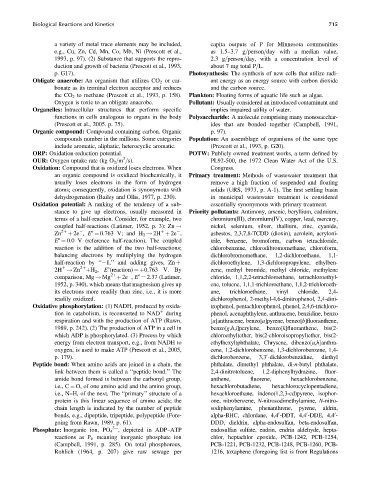Page 760 - Fundamentals of Water Treatment Unit Processes : Physical, Chemical, and Biological
P. 760
Biological Reactions and Kinetics 715
a variety of metal trace elements may be included, capita outputs of P for Minnesota communities
e.g., Cu, Zn, Cd, Mn, Co, Mb, Ni (Prescott et al., as 1.5–3.7 g=person=day with a median value,
1993, p. 97). (2) Substance that supports the repro- 2.3 g=person=day, with a concentration level of
duction and growth of bacteria (Prescott et al., 1993, about 7 mg total P=L.
p. G17). Photosynthesis: The synthesis of new cells that utilize radi-
Obligate anaerobe: An organism that utilizes CO 2 or car- ant energy as an energy source with carbon dioxide
bonate as its terminal electron acceptor and reduces and the carbon source.
the CO 2 to methane (Prescott et al., 1993, p. 158). Plankton: Floating forms of aquatic life such as algae.
Oxygen is toxic to an obligate anaerobe. Pollutant: Usually considered an introduced contaminant and
Organelles: Intracellular structures that perform specific implies impaired utility of water.
functions in cells analogous to organs in the body Polysaccharide: A molecule comprising many monosacchar-
(Prescott et al., 2005. p. 75). ides that are bonded together (Campbell, 1991,
Organic compound: Compound containing carbon. Organic p. 97).
compounds number in the millions. Some categories Population: An assemblage of organisms of the same type
include aromatic, aliphatic, heterocyclic aromatic. (Prescott et al., 1993, p. G20).
ORP: Oxidation-reduction potential. POTW: Publicly owned treatment works, a term defined by
3
OUR: Oxygen uptake rate (kg O 2 =m =s). PL92-500, the 1972 Clean Water Act of the U.S.
Oxidation: Compound that is oxidized loses electrons. When Congress.
an organic compound is oxidized biochemically, it Primary treatment: Methods of wastewater treatment that
usually loses electrons in the form of hydrogen remove a high fraction of suspended and floating
atoms; consequently, oxidation is synonymous with solids (URS, 1973, p. A-1). The first settling basin
dehydrogenation (Bailey and Ollis, 1977, p. 230). in municipal wastewater treatment is considered
Oxidation potential: A ranking of the tendency of a sub- essentially synonymous with primary treatment.
stance to give up electrons, usually measured in Priority pollutants: Antimony, arsenic, beryllium, cadmium,
terms of a half-reaction. Consider, for example, two chromium(III), chromium(IV), copper, lead, mercury,
nickel, selenium, silver, thallium, zinc, cyanide,
coupled half-reactions (Latimer, 1952, p. 3): Zn !
Zn 2þ þ 2e , E8 ¼ 0.763 V; and H 2 ! 2H þ 2e , asbestos, 2,3,7,8-TCDD (dioxin), acrolein, acryloni-
þ
E8 ¼ 0.0 V (reference half-reaction). The coupled trile, benzene, bromoform, carbon tetrachloride,
reaction is the addition of the two half-reactions; chlorobenzene, chlorodibromomethane, chloroform,
balancing electrons by multiplying the hydrogen dichlorobromomethane, 1,2-dichloroethane, 1,1-
dichloroethylene, 1,3-dichloropropylene, ethylben-
half-reaction by ‘‘ 1,’’ and adding gives, Zn þ
2H ! Zn þH 2 , E8(reaction) ¼þ0.763 V. By zene, methyl bromide, methyl chloride, methylene
þ
2þ
comparison, Mg ! Mg þ 2e , E8 ¼ 2.37 (Latimer, chloride, 1,1,2,2-tetrachloroethane, tetrachloroethyl-
2þ
1952, p. 340), which means that magnesium gives up ene, toluene, 1,1,1-trichloroethane, 1,1,2-trichloroeth-
its electrons more readily than zinc, i.e., it is more ane, trichloroethane, vinyl chloride, 2,4-
readily oxidized. dichlorophenol, 2-methyl-4,6-dinitrophenol, 2,4-dini-
Oxidative phosphorylation: (1) NADH, produced by oxida- trophenol, pentachlorophenol, phenol, 2,4,6-trichloro-
tion in catabolism, is reconverted to NAD during phenol, acenaphthylene, anthracene, benzidine, benzo
þ
respiration and with the production of ATP (Rawn, [a]anthracene, benzo[a]pyrene, benzo[b]fluoranthene,
1989, p. 242). (2) The production of ATP in a cell in benzo[g,h,i]perylene, benzo[k]fluoranthene, bis(2-
which ADP is phosphorylated. (3) Process by which chloroethyl)ether, bis(2-chloroisopropyl)ether, bis(2-
energy from electron transport, e.g., from NADH to ethylhexyl)phthalate, Chrysene, dibenzo[a,h]anthra-
oxygen, is used to make ATP (Prescott et al., 2005, cene, 1,2-dichlorobenzene, 1,3-dichlorobenzene, 1,4-
p. 179). dichlorobenzene, 3,3 -dichlorobenzidine, diethyl
0
Peptide bond: When amino acids are joined in a chain, the phthalate, dimethyl phthalate, di-n-butyl phthalate,
link between them is called a ‘‘peptide bond.’’ The 2,4-dinitrotoluene, 1,2-diphenylhydrazine, fluor-
amide bond formed is between the carbonyl group, anthene, fluorene, hexachlorobenzene,
i.e., C ¼ O, of one amino acid and the amino group, hexachlorobutadiene, hexachlorocyclopentadiene,
i.e., N–H, of the next. The ‘‘primary’’ structure of a hexachloroethane, indeno(1,2,3-cd)pyrene, isophor-
protein is this linear sequence of amino acids; the one, nitrobenzene, N-nitrosodimethylamine, N-nitro-
chain length is indicated by the number of peptide sodiphenylamine, phenanthrene, pyrene, aldrin,
bonds, e.g., dipeptide, tripeptide, polypeptide (Fore- alpha-BHC, chlordane, 4,4 -DDT, 4,4 -DDE, 4,4 -
0
0
0
going from Rawn, 1989, p. 61). DDD, dieldrin, alpha-endosulfan, beta-endosulfan,
Phosphate: Inorganic ion, PO 4 , depicted in ADP–ATP endosulfan sulfate, endrin, endrin aldehyde, hepta-
3
reactions as P i , meaning inorganic phosphate ion chlor, heptachlor epoxide, PCB-1242, PCB-1254,
(Campbell, 1991, p. 285). On total phosphorous, PCB-1221, PCB-1232, PCB-1248, PCB-1260, PCB-
Rohlich (1964, p. 207) give raw sewage per 1216, toxaphene (foregoing list is from Regulations

